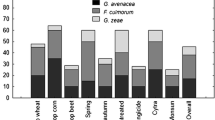Abstract
In 1997–99 the occurrence ofFusarium spp. on winter wheat and the contamination with mycotoxins was investigated at three locations in the Rhineland, Germany. All cultivation methods investigated had an effect on the level ofFusarium infection, however, rainfall during flowering was the most important factor. The choice of cultivar and soil cultivation proved to be the most promising tools to reduce head scab severity and mycotoxin contamination.
Zusammenfassung
Von 1997–99 wurde das Auftreten vonFusarium spp. sowie die Belastung von Weizen mit Mykotoxinen an drei Standorten im Rheinland untersucht. Alle pflanzenbaulichen Maßnahmen konnten zu einer Reduktion der Befallshöhe führen, entscheidend für den Befall war aber die Witterung während der Blüte. Sortenwahl und Bodenbearbeitung erwiesen sich als am wirksamsten, den Ährenbefall und die Mykotoxinbelastung zu reduzieren.
Similar content being viewed by others
References
Abildgren MP, Lund F, Thrane U, Elmholt S (1987) Czapek-Dox agar containing iprodione and dicloran as a selective medium for the isolation ofFusarium species. Letters in Applied Microbiology 5: 83–86
Caron D, Jugnet MP, Maumene C (1994) Efficacité in vitro et en plein champ des principales matières actives fongicides sur la fusariose des épis. ANPP- Quatrième conférence international sur les Maladies des Plantes Bordeaux-6-8 Décembre 1994
Dirheimer G (1998) Recent advances in the genotoxicity of mycotoxins. Révue Médicine Vétérinaire 149: 605–616
Ehling G, Cockburn A, Snowdon P, Buschhaus H (1998) The significance of theFusarium toxin deoxynivalenol (DON) for human and animal health. Révue Médicine Vétérinaire 149: 715–719
Häni F (1979) Über Getreidefusariosen in der Schweiz: Saatgutbefall, Ährenbefall und Bodenkontamination. Zeitschrift für Pflanzenkrankheiten und Pflanzenschutz 87: 257–280
Nelson PE, Toussoun TA, Marasas WFO (1983)Fusarium species. Illustrated manual for identification. Pennsylvania State University Press, University Park London, 193 pp.
Nirenberg HI (1976) Untersuchungen über die morphologische und biologische Differenzierung in derFusarium-Sektion Liseola. Mitt. Biol. Bundesanst. für Land- und Forstwirtschaft 169: 1–117
Perkowski J, Plattner RD, Golinski P, Versonder RF, Chelkowski J (1990) Natural occurrence of deoxynivalenol, 3-acetyl-deoxynivalenol, 15-acetyl-deoxynivalenol, nivalenol, 4,7-dideoxynivalenol and zearalenone in Polish wheat. Mycotoxin Research 6: 7–12
Weinert J, Wolf GA (1995) Gegen Ährenfusariosen helfen nur resistente Sorten. Pflanzenschutzpraxis 2: 30–32
Author information
Authors and Affiliations
Rights and permissions
About this article
Cite this article
Meier, A., Birzele, B., Oerke, E. et al. Impact of growth conditions on the occurrence ofFusarium spp. and the mycotoxin content of wheat. Mycotox Res 16 (Suppl 1), 12–15 (2000). https://doi.org/10.1007/BF02942971
Issue Date:
DOI: https://doi.org/10.1007/BF02942971




